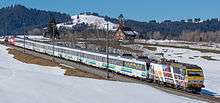Voralpen Express
 Voralpen-Express with Re 456 head and tail pulling out of Biberbrugg railway station towards Rothenthurm | |
| Overview | |
|---|---|
| Service type | InterRegio |
| First service | 1992 |
| Current operator(s) | SOB (since December 2013) |
| Former operator(s) | SBB, SOB (until December 2013) |
| Route | |
| Start | Luzern, LU |
| End | St. Gallen, SG |
| Average journey time | 2 hours 15 minutes |
| Service frequency | every hour |
| Train number(s) | 2402 - 2442 |
| On-board services | |
| Class(es) | First and Second Class |
| Seating arrangements | First Class carriage with panorama view. Second class coach seating |
| Catering facilities | Vending machines |
| Technical | |
| Rolling stock | see article |
| Track gauge | 1,435 mm (4 ft 8 1⁄2 in) |
| Electrification | 15kV 16,7 Hz AC Overhead |
| Timetable number(s) | 600; 670; 870; |
The Voralpen-Express (VAE, Pre-Alpine Express) is a named train connecting medium-sized cities in central and eastern Switzerland, carrying this name since 1992. It is operated by Südostbahn (SOB) and runs every hour between St. Gallen and Lucerne.
History
The first through trains from Romanshorn to Arth-Goldau started in 1940 after the electrification of the Südostbahn line between Rapperswil and Arth-Goldau. Romanshorn–Rapperswil had been under wires since 1926/31. The trains were jointly operated by Bodensee–Toggenburg-Bahn (BT), Südostbahn (SOB) and the Swiss Federal Railways (SBB). 1944 BT added buffet cars to the trainsets. 1947 some trains continued from Arth-Goldau to Lucerne. In 1960 operation was changed to push-pull operation with very powerful motor coaches. The trainsets were now painted in green an cream. 1982 brought the clock-face timetable with a train Romanshorn–Lucerne every two hours but also the end for buffet cars. In 1991 BT and SOB bought EW IV inter-city coaches to replace the push-pull sets. 1995 unnamed trains every two hours were added between Romanshorn and Arth-Goldau, again with push-pull sets. After Revvivo-coaches had been used for these trains from 1997 on, it was decided to sell the EW IV to SBB and buy more Revvivos to allow an hourly push-pull trainset between Romanshorn and Lucerne. 2001 BT and SOB merged into the new SOB, which reduced the number of participating companies to two. VAE ran as an InterRegio (IR) express train until 2013.
On 15 December 2013 the concept changed and SOB became the sole operator. VAE became a distinct train category but the train was limited to St. Gallen–Lucerne. To cope with the increasing number of passengers, trains now generally have seven coaches, which means that two locomotives or motor coaches are needed. This is due to the 50‰ (1:20) grades between Pfäffikon SZ and Arth-Goldau. Motive power is at each end, allowing a push-pull service without driving trailers.
Geography
Besides creating a tangential link on the southern edge of the greater Zurich area, it is popular for the pre-alpine scenery. The most important stations with connecting trains and regular boat lines on the lakes are:
- Lucerne: GoldenPass Line, Lake Lucerne (Vierwaldstättersee), Pilatus mountain
- Arth-Goldau: trains through the Gotthard Rail Tunnel to Ticino and Italy; cog-wheel train to Rigi mountain
- Biberbrugg: to Einsiedeln
- Pfäffikon: line to Chur (Grisons), Lake Zurich
- Rapperswil: "rose town", Lake Zurich crossing the Seedamm
- Wattwil: Churfirsten and Toggenburg
- Herisau: Appenzell (narrow gauge network of Appenzeller Bahnen)
- St. Gallen: UNESCO World Heritage abbey library, trains to Austria and Germany
- Romanshorn: Lake Constance (Bodensee), ferry to Friedrichshafen (Germany)
Rolling stock
Fourteen locomotioves and motor coaches form seven pairs of motive power for the Voralpen-Express:
- 4 Locomotives Re 446: 91 85 4 446 015–018 (as pairs)
- 6 Locomotives Re 456: 91 85 4 456 091–096 (as pairs)
- 4 NPZ motor coaches RBDe 561: 94 85 7 561 081–084 (as pairs)
The different types cannot be combined. If less than five pairs are available, SOB leases a Re 4/4 II from SBBC (in February 2014 it was Re 421 393) which can be used together with an Re 446.
Five trainsets are needed for the daily operation and a sixth set is in Herisau as a reserve. It allows to exchange the sets in order to clean and maintain them. The six sets are formed from two locomotives with seven coaches:
- Re–ABt–B–B–BR–A–B–B–Re (4 sets)
or with two motor coaches and six coaches:
- RBDe–A–B–B–BR–A–B–RBDe (2 sets)
The seventh pair of locomotives is an additional reserve. Thus, if one motor coach RBDe needs maintenance, an additional set with locomotives will be formed.
31 air-conditioned Revvivo coaches, 1997/99 rebuilt from Einheitswagen I coaches, are the backbone of the VAE coaching stock. Ten quite recent NPZ vehicles (1991/95) were added to the stock to allow for enough capacity. Four older coaches are kept as a reserve but the Revvivo prototype of 1995 (BR 748) has been withdrawn.
- 8 Revvivo-A 50 85 18-35 711–718
- 1 A Bodan 50 85 17-35 719 (ex SBB B 6000 - BT B 350; rebuilt 1991, reserve)
- 16 Revvivo-B 50 85 20-35 721–736 (735–736 with Schlieren bogies)
- 7 Revvivo-BR 50 85 20-35 741–747 (741–744 ex BT AB 251–254) (1 reserve)
- 6 NPZ-B (1991) 50 85 29-35 781–786 (as pairs)
- 4 NPZ-ABt (1995) 50 85 80-35 181–184 (as intermediate trailer)
- 3 B EW I ex BT (1967-68) 50 85 20-35 753, 754, 767 (reserve)
External links
![]() Media related to Voralpen-Express at Wikimedia Commons
Media related to Voralpen-Express at Wikimedia Commons